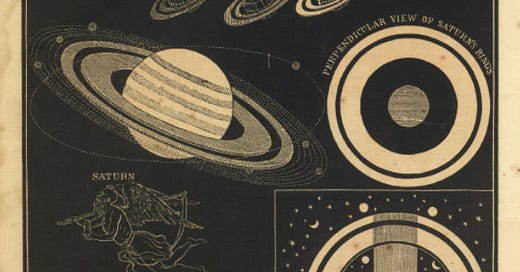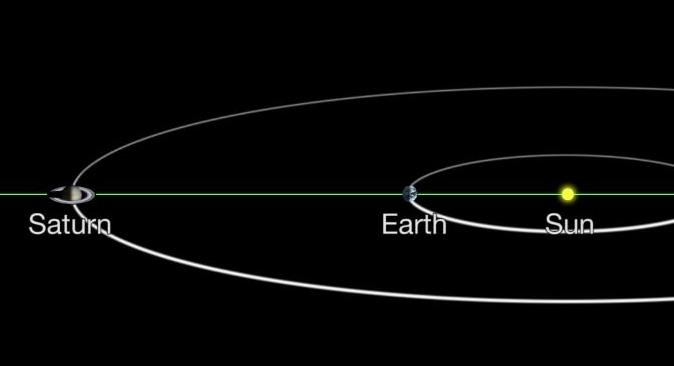Saturn by Asa Smith, 1855, from the David Rumsey Historical Map Collection
Beautiful Saturn, so striking in appearance - and so bright in our skies that even those of us in cities can pick it out easily - is about to put on a good late-summer show. With the weather hopefully clearing a little in the UK after such an overcast summer, the next couple of weeks is the time to get outside at night and look up.
Saturn will be at ‘opposition’ on the 27th August, which means at its brightest, closest and highest in our skies.
Here’s a very simple image to show you what is happening.
All of the planets are orbiting around the sun all of the time, including our very own Earth, of course. We are all doing it at different paces, and generally the further out you go, the slower the planets orbit. So while we speed around the sun once per year, Saturn takes a leisurely 29.4 of our Earth years. Each time we whizz around there is of course a moment when we are at the closest we are ever going to get to Saturn, a date that changes slightly each year because Saturn plods around its orbit. That date falls this year on the 27th.
But it is not just the fact that Saturn is at its closest to us that makes this moment so great for Saturn watching. In addition it also means that it is opposite the sun in our sky. As we spin on our axis the sun is of course high in the sky all through the day, and then when we spin around into our night time…well there is Saturn waiting for us, perfectly opposite and so travelling across our sky all night long. It rises in the east at sunset, travels to its highest point in the sky by between midnight and 1am, and sets in the west at dawn.
Plus, because Saturn is opposite to the sun in our sky it is fully lit up, like the full moon: essentially a planet in opposition is a ‘full planet’, in exactly the same way the moon is sometimes a full moon.
I am flagging this up now because although the night of the 27th is the peak, the week or so either side should be pretty impressive too. And just to be clear, what I mean by all of this is that not only can you see it with the naked eye, but it will be bright and clear and beautiful, even in lit-up areas. There really is nothing like looking out of your window and picking out an outer solar-system planet for simultaneously blowing your mind and putting a few things into perspective.
To take this one step further, look at it through binoculars or even the most basic telescope and you might be in for a particular treat. Take a look at this…
Saturn’s closing rings, from this site
Here you can see the progression of Saturn’s rings, which were very open indeed in 2016/17/18 and have been closing since, so Saturn is not now as bright and impressive as it has been in previous years but its still worth looking for those rings. Saturn’s rings open and close on a 14 year cycle - when the rings are ‘open’ the pole is pointing more towards us, so opening up the rings, and when they are ‘closed’ we are looking at its equator and the rings are thin and hard to pick out. As you can see we are now heading into the phase where they will be so ‘closed’ that we will barely be able to see them. This might be the last year for quite a few years that you can look up into the sky and actually pick out Saturn’s rings, so I strongly suggest you give it a go over the next couple of weeks. Do report back if you spot it!
Much of this information is from my book, The Almanac 2023, and the new edition, The Almanac 2024, is out next Thursday! There is still time to pre-order it so that it drops onto your doormat on the release day. Find it at Waterstones, Blackwells, Hive, Amazon, and your friendly neighbourhood independent bookshop. Thank you!






